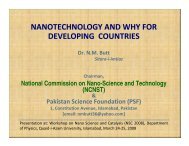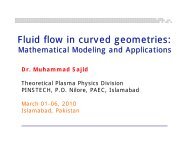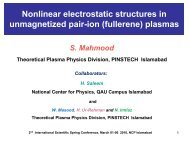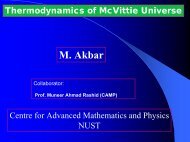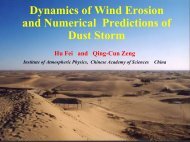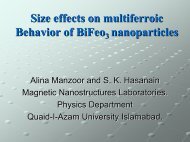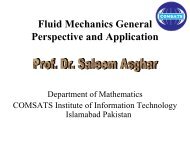On the growth of rare earth doped LiYF4 thin film by pulsed laser ...
On the growth of rare earth doped LiYF4 thin film by pulsed laser ...
On the growth of rare earth doped LiYF4 thin film by pulsed laser ...
- No tags were found...
Create successful ePaper yourself
Turn your PDF publications into a flip-book with our unique Google optimized e-Paper software.
<strong>On</strong> <strong>the</strong> <strong>growth</strong> <strong>of</strong> <strong>rare</strong> <strong>earth</strong> <strong>doped</strong> LiYF 4<strong>thin</strong> <strong>film</strong>s <strong>by</strong> <strong>pulsed</strong> <strong>laser</strong> depositionDr. M.Anwar-ul-HaqPr<strong>of</strong>. Paola BicchiDr. Stefano BarsantiDepartment <strong>of</strong> Physics,University <strong>of</strong> Sargodha,PakistanDepartment <strong>of</strong> Physics,University <strong>of</strong> Siena, ItalyInternational Scientific Spring at NCP from March 01-06, 20101
Layout <strong>of</strong> <strong>the</strong> presentationIntroductionThin <strong>film</strong>sPulsed Laser Deposition (PLD)Experimental setupResultsNd 3+ :LiYF 4 <strong>thin</strong> <strong>film</strong>sConclusions2
IntroductionAim <strong>of</strong> <strong>the</strong> research workDevelopment <strong>of</strong> <strong>rare</strong> <strong>earth</strong> (RE) ions-<strong>doped</strong> LiYF 4(YLF) fluoride <strong>thin</strong> <strong>film</strong>s with characteristics suitablefor <strong>the</strong>ir use as active medium in micro-<strong>laser</strong>s sourcesin <strong>the</strong> 1-2 μm, via Pulsed Laser Deposition (PLD)Materials usedTargetsSubstratesRE ions- <strong>doped</strong> mono-crystalline YLFNd 3+ or Tm 3+Pure mono-crystalline YLF3
IntroductionWhy <strong>thin</strong> <strong>film</strong> in micro-<strong>laser</strong> area? [1,2]The realization <strong>of</strong> active optical devices in <strong>film</strong> shapewould magnifies all advantages <strong>of</strong> <strong>the</strong> micro-<strong>laser</strong>ssystems <strong>by</strong> favoring; The removal <strong>of</strong> <strong>the</strong> heat in excess from <strong>the</strong> active media Enhancement <strong>of</strong> <strong>the</strong> confinement <strong>of</strong> <strong>the</strong> radiationsMaximizes <strong>the</strong> interaction zone between pump and active mediaReduction <strong>of</strong> <strong>the</strong> lasing threshold[1] D. B. Chrisey and G. K. Hubler, (Eds.), Pulsed <strong>laser</strong> deposition <strong>of</strong> <strong>thin</strong> <strong>film</strong>s, John Wiley, New York (1994)[2] C. L. Bonner, A. A. Anderson, R. W. Eason, D. P. Shepherd, D. S. Gill, C. Grivas and N. Vainos, Opt. Lett. 22 (1997) 9884
Thin Films [3]DimensionsRealizationfrom fractions <strong>of</strong> a nanometer to severalmicrometers in thicknesson a suitable substrate or on previously deposited layersGrowth Mechanism [4][3] K. Wasa, M. Kitabatake and H. Adachi, Thin <strong>film</strong> materials technology: sputtering <strong>of</strong> compound materials, Springer, Heidelberg (2004)5[4] A. Rockett, The materials science <strong>of</strong> semiconductors, Springer, New York (2007)
Thin <strong>film</strong>sMajor ways <strong>of</strong> <strong>thin</strong> <strong>film</strong>s <strong>growth</strong> [5]Volmer-Weber <strong>growth</strong>(Island <strong>growth</strong>)Frank-van de Merwe <strong>growth</strong>(layer <strong>by</strong> layer <strong>growth</strong>)Stranski-Krastinov <strong>growth</strong>(mixed <strong>growth</strong>)[5] J. A. Venables, G. D. T. Spiller and M. Hanbucken, Rep. Prog. Sci. 47 (1984) 3996
Thin <strong>film</strong>sThin <strong>film</strong> <strong>growth</strong> techniques [1] Liquid Phase Epitaxy Thermal Evaporation Sputtering Molecular Beam Epitaxy Chemical Vapour Deposition Ion ImplantationPulsed <strong>laser</strong> depositionEjection <strong>of</strong> materials from <strong>the</strong> target <strong>by</strong> highlyenergetic <strong>laser</strong> pulses, with subsequentdeposition/condensation on a suitable substrate[1] D. B. Chrisey and G. K. Hubler, (Eds.), Pulsed <strong>laser</strong> deposition <strong>of</strong> <strong>thin</strong> <strong>film</strong>s, John Wiley, New York (1994)7
Thin <strong>film</strong>sPulsed Laser Deposition (PLD) [1,6]Interaction <strong>of</strong> <strong>the</strong> photons with<strong>the</strong> target causes material ejectionvia a <strong>the</strong>rmal and / or electronicprocessThe ablated plume is a mixture <strong>of</strong>energetic particles such as atoms,molecules, electrons, ions, submicronsor micron-sized solidparticles and molten globulesTypical PLD experimental setup[1] D. B. Chrisey and G. K. Hubler, (Eds.), Pulsed <strong>laser</strong> deposition <strong>of</strong> <strong>thin</strong> <strong>film</strong>s, John Wiley, New York (1994)8[6] P. R. Willmott and J. R. Huber, Rev. Mod. Phys. 72 (2000) 315
Thin <strong>film</strong>sPLDAdvantages <strong>of</strong> PLD [6,7]<strong>laser</strong> external to <strong>the</strong> ablation/deposition chamber,flexibility <strong>of</strong> <strong>the</strong> experimental set-up,possibility <strong>of</strong> getting <strong>thin</strong> <strong>film</strong>s <strong>of</strong> almost any kind <strong>of</strong> material,deposition can be performed ei<strong>the</strong>r in vacuum or in presence<strong>of</strong> a controlled background atmospherestoichiometry in <strong>the</strong> <strong>film</strong> can be maintained,<strong>film</strong>s <strong>growth</strong> rates can be controlled,multiple layer <strong>film</strong>s can be grown,deposition on substrates kept at any temperature, is possible[6] P. R. Willmott and J. R. Huber, Rev. Mod. Phys. 72 (2000) 315[7] J. Schou, Appl. Surf. Sci. 255 (2009) 51919
Thin <strong>film</strong>sPLDWhy fluorides?Crystals <strong>doped</strong> with <strong>rare</strong> <strong>earth</strong>Laser sources in IR Oxides FluoridesAdvantages <strong>of</strong> fluorides over oxides [8, 9]Stronger emission cross sectionsLower phonon energyDisadvantagesSensitive to <strong>the</strong>rmal shocks even for slow <strong>the</strong>rmal gradient and to OH¯ radicalcontamination during <strong>growth</strong> even a few ppmFilms <strong>of</strong> RE ions-<strong>doped</strong> fluoridesExcellent optical properties+ Benefits <strong>of</strong> <strong>thin</strong> <strong>film</strong>[8] A. A. Kaminskii, Laser Crystals, Springer-Verlag, New York (1981)10[9] C. Garapon, S. Guy, S. Skasasian, A. Bensalah, C. Champeaux and R. Brenier, Appl. Phys. A 91 (2008) 493
ExperimentalsetupSubstrateSubstrate materialmono-crystalline YLFProperties <strong>of</strong> YLF crystal [11]YLF CrystalRadius ~ 4.7 – 7.2 mmThickness ~ 2 mmChemical FormulaWeightCrystal StructureMelting PointExperimental setupHardnessTransparencyDensityRefractive IndexesCrystallographic axisUnit cell <strong>of</strong> YLF [10]LiYF 4171.8 amuTetragonal819°C5.07 Mohs0.12- 7.3 µm3.99 g/cm 3n o= 1.4485n e= 1.4708Monoaxis (a, c)[10] E. Garcia and R. R. Ryan, Acta Crystallogr., Sect C 49 (1993) 2053[11] R. L. Aggarwal, D. J. Ripin, J. R. Ochoa and T. Y. Fan, J. Appl. Phys. 98 (2005) 10351411
ExperimentalsetupTarget materialsTarget crystalsDopant Concentration (at. %) N (cm -3 )11.4 x10 20Nd 3+1.52.1 x10 20Nd 3+ :LiYF 4 (Nd:YLF)Radius ~ 4.7 – 7.2 mm, Thickness ~ 3 mmThe YLF and Nd:YLF mono-crystals used during our PLD experiments were ei<strong>the</strong>rgrown <strong>by</strong> <strong>the</strong> NEST <strong>growth</strong> facility in Pisa or provided <strong>by</strong> a commercial supplier(VLOC, USA).12
ExperimentalsetupFilm <strong>growth</strong> systemAblation setupDeposition setup13
ExperimentalsetupPhotos <strong>of</strong> <strong>the</strong> UHV chamberGas valveVacuum gaugesAuxiliary viewportsLaserPlumeLaser entrancewindowHeaterConnectionsRotatingtarget holderSubstrate heater/holderholderShutter14
ExperimentalsetupPLD processHeatedsubstrateAdiabaticexpansionKnudsen layer15
ExperimentalsetupFilm in-situ analysisRealization <strong>of</strong> <strong>the</strong> <strong>film</strong> <strong>growth</strong>To verify <strong>the</strong> presence <strong>of</strong> <strong>the</strong> <strong>rare</strong> <strong>earth</strong> ions in <strong>the</strong> <strong>film</strong>16
ExperimentalsetupCCD camera photo <strong>of</strong> <strong>the</strong> Nd:YLF <strong>film</strong>sThe <strong>film</strong> was deposited with <strong>laser</strong> fluency <strong>of</strong> 10 J/cm 2 in 1 Pa <strong>of</strong> Heatmosphere at a substrate temperature <strong>of</strong> 650 °C.17
ExperimentalsetupFilm ex-situ characterisationsDetermining <strong>the</strong> kind <strong>of</strong> <strong>film</strong> depositedTo determine if <strong>the</strong> orientation from <strong>the</strong> substrateto <strong>the</strong> <strong>film</strong> has been transferredConcentration <strong>of</strong> Nd³ + ions presentSurface quality18
ExperimentalsetupSimplified level scheme and absorption curve for Nd:YLF [12,13]Simplified level schemeAbsorption curve• The fluorescence pr<strong>of</strong>iles <strong>of</strong> Nd 3+ -<strong>doped</strong> YLF crystals depend on <strong>the</strong>y being recorded with E ||or E ⊥ to <strong>the</strong> crystal c-axis [13].• The Nd 3+ 4 F 3/2 manifold lifetime is concentration dependent in such a way that lowerconcentrated samples manifest a higher lifetime and vice versa [13].[12] A. A. S. da Gama, G. F. de Sa, P. Porcher and P. Caro, J. Chem. Phys. 75 (1981) 2583[13] J. R. Ryan and R. Beach, J. Opt. Soc. Am. B:Opt. Phys. 9 (1992) 188319
ExperimentalsetupSetup for <strong>the</strong> ex-situ characterization20
ResultsPlume analysisAblation in vacuumAblation in 1 Pa <strong>of</strong> HeResults21
ResultsPlume analysis• The expansion velocities <strong>of</strong> <strong>the</strong> plume species were found reduced in presence<strong>of</strong> 1 Pa <strong>of</strong> He.• Both in vacuum and in 1 Pa <strong>of</strong> He, <strong>the</strong> expansion velocity <strong>of</strong> most <strong>of</strong> <strong>the</strong> plumecomponents saturates beyond 8 J/cm 2 .• Ablation threshold in vacuum for all <strong>the</strong> species was found to be 1.7 ± 0.3J/cm 2 with exception <strong>of</strong> Li for which 0.7 ± 0.3 J/cm 2 .• In vacuum, all <strong>the</strong> plume species were focused along <strong>the</strong> target normal exceptlightest neutral Li, which was found to point preferentially at 16° to <strong>the</strong> targetnormal.• In presence <strong>of</strong> 1 Pa <strong>of</strong> He, Li and all o<strong>the</strong>r plume species were focused along <strong>the</strong>target normal.• The FWHM <strong>of</strong> <strong>the</strong> angular distribution curves <strong>of</strong> <strong>the</strong> plume components wasfound reduced in 1 Pa <strong>of</strong> He compared to <strong>the</strong> similar measurements done invacuum and gave indication <strong>of</strong> <strong>the</strong> confinement <strong>of</strong> <strong>the</strong> plume in <strong>the</strong> presence <strong>of</strong>1 Pa <strong>of</strong> He.22
ResultsPlume shape(a) Vacuum(b) 1 Pa <strong>of</strong> He23
ResultsNd:YLF <strong>thin</strong> <strong>film</strong>sDeposition at T s = 650°CPLD in vacuumPLD in 1 Pa <strong>of</strong> HeLow (4 J/cm 2 )and high (10 J/cm 2 )<strong>laser</strong> fluency24
Results• Vacuum - T s =650°CHigh fluency (10 J/cm 2 )Deposition conditionsLaser wavelength355 nmRepetition rateLaser Pulse durationLaser fluency10 Hz13 ns10 J/cm²Ablation time 20’TargetNd:YLF 1.5% at.SubstrateYLFVacuum 1 ×10-4 PaTarget-substrate distance35 mmTemperature <strong>of</strong> <strong>the</strong> substrate 650°C25
Results• Vacuum - T s =650°CHeating/cooling cycle <strong>of</strong> <strong>the</strong> substrate for <strong>film</strong> deposition26
Results• Vacuum - T s =650°CFilms in-situ analysisRealization <strong>of</strong> <strong>the</strong> <strong>film</strong>Presence <strong>of</strong> Nd 3+ ions in <strong>the</strong> <strong>film</strong>Example <strong>of</strong> interference pattern produced<strong>by</strong> a <strong>film</strong> deposited in vacuumPortion <strong>of</strong> <strong>the</strong> LIF spectrum following 355 nm excitation, recordedin <strong>the</strong> Nd:YLF bulk crystal and from a <strong>film</strong> grown in vacuum with10J/cm 2 <strong>laser</strong> fluency.27
Films ex-situ characterizations28
Results• Vacuum - T s =650°CUnpolarized, normalized, fluorescence spectraλ exc = 806.6 nm4F 3/2 → 4 I 9/24F 3/2 → 4 I 11/2Crystalline Nd:YF <strong>film</strong>From Ref. [14][14] S. Barsanti, F. Comacchia, A. Di Lieto, A. Toncelli, M. Tonelli and P. Bicchi, Thin Solid Films 516 (2008) 200929
Results• Vacuum - T s =650°CLife time measurement <strong>of</strong> <strong>the</strong> 4 F 3/2 manifoldFilm deposited at T s =650°Cin vacuum with F l = 10 J/cm 2Film deposited at T s =650°C invacuum with F l =4 J/cm 2 [14]τ Target = 464 ± 2 μsτ Film= 242 ± 5 μsNd:YF <strong>film</strong>[14] S. Barsanti, F. Comacchia, A. Di Lieto, A. Toncelli, M. Tonelli and P. Bicchi, Thin Solid Films 516 (2008) 200930
Results• 1 Pa <strong>of</strong> He - T s =650°CDeposition in presence <strong>of</strong> 1 Pa <strong>of</strong> HeLaser wavelengthDeposition parameters355 nmRepetition rateLaser Pulse durationLaser fluencyAblation timeTargetSubstrateBack ground atmosphereTarget-substrate distanceTemperature <strong>of</strong> <strong>the</strong> substrate10 Hz13 ns4J/cm²85’Nd:YLF 1.5% at.YLF1 Pa <strong>of</strong> He35 mm650°C31
Results• 1 Pa <strong>of</strong> He - T s =650°CUnpolarized, normalized, fluorescence spectraλ exc = 806.6 nm4F 3/2 → 4 I 9/24F 3/2 → 4 I 11/2InhomogeneousCrystalline Nd:YLF <strong>film</strong>32
Results• 1 Pa <strong>of</strong> He - T s =650°CConcentration <strong>of</strong> Nd 3+ ions in <strong>the</strong> <strong>film</strong>λ exc = 806.6 nm Single exponential decay4F 3/2 manifold lifetimeτ Target = 464 ± 2 μsτ Film average= 437 μsVariation from point to point ~ ± 10%Average Nd 3+ ion concentration in <strong>the</strong><strong>film</strong> greater than in <strong>the</strong> target33
Results• 1 Pa <strong>of</strong> He - T s =650°CMorphological analysisVolmer-Weber <strong>growth</strong>34
Results• 1 Pa <strong>of</strong> He - T s =650°CHigh fluency (10 J/cm 2 )Deposition conditionsLaser wavelengthRepetition rate355 nm10 HzLaser Pulse duration13 nsLaser fluency10 J/cm²Ablation time 20’TargetNd:YLF 1.5% at.SubstrateBack ground atmosphereTarget-substrate distanceYLF1 Pa <strong>of</strong> He35 mmTemperature <strong>of</strong> <strong>the</strong> substrate 650°C35
Results• 1 Pa <strong>of</strong> He - T s =650°CUnpolarized, normalized, fluorescence spectraλ exc = 806.6 nm4F 3/2 → 4 I 9/24F 3/2 → 4 I 11/2HomogeneousCrystalline Nd:YLF <strong>film</strong>36
Results• 1 Pa <strong>of</strong> He - T s =650°COptical analysis ⎪⎪ and ⊥ to c-axis4F 3/2 → 4 I 9/24F 3/2 → 4 I 11/24F 3/2 → 4 I 9/24F 3/2 → 4 I 11/2The transition <strong>of</strong> interest for <strong>the</strong> possible lasing action wasfavored in <strong>the</strong> <strong>film</strong> as much as in <strong>the</strong> bulk.37
Results• 1 Pa <strong>of</strong> He - T s =650°COptical analysis ⎪⎪ and ⊥ to c-axisTransition 4 F 3/2 → 4 I 9/2The spectral pr<strong>of</strong>ile in <strong>the</strong> <strong>film</strong> and in<strong>the</strong> bulk changes in <strong>the</strong> same way inshifting <strong>the</strong> polarization from E || to E ⊥to <strong>the</strong> c-axis.The global spectral intensity, in both <strong>the</strong>emissions is higher when E || to c-axiswith only exception <strong>of</strong>⎛⎜⎝II|| 863⊥863//II|| 867⊥867⎞⎟⎠T arget≈3⎛⎜⎝II|| 863⊥863//II|| 867⊥867⎞⎟⎠Film≈238
Results1 Pa <strong>of</strong> He - T s =650°COptical analysis ⎪⎪ and ⊥ to c-axisTransition 4 F 3/2 → 4 I 11/2The spectral pr<strong>of</strong>ile in <strong>the</strong> <strong>film</strong> and in<strong>the</strong> bulk remains <strong>the</strong> same in shifting <strong>the</strong>polarization from E || to E ⊥ to <strong>the</strong> c-axis.Some features compatible The with only a mismatch considerable if notcomplete transfer <strong>of</strong> orientation from <strong>the</strong> substrateto <strong>the</strong> <strong>film</strong>( I I ) 1. 21047 1053≈Film( I I ) 1. 21053 1047≈T arget39
Results• 1 Pa <strong>of</strong> He - T s =650°CConcentration <strong>of</strong> Nd 3+ ions in <strong>the</strong> <strong>film</strong>λ exc = 806.6 nm Single exponential decay4F 3/2 manifold lifetimeτ Target = 464 ± 2 μsτ Film = 468 ± 5 μsτ Target = τ FilmSame Nd 3+ ion concentration in<strong>the</strong> <strong>film</strong> and <strong>the</strong> target40
Results• 1 Pa <strong>of</strong> He - T s =650°CMorphological analysisMixed <strong>growth</strong>41
ConclusionsWe succeeded to deposit crystalline YLF <strong>film</strong>s <strong>doped</strong> with Nd 3+ .The best <strong>film</strong> produced which showed promising optical qualities to reach<strong>the</strong> goal <strong>of</strong> this project was <strong>the</strong> Nd:YLF one obtained in 1 Pa <strong>of</strong> He with a<strong>laser</strong> fluency <strong>of</strong> 10 J/cm 2 , when T s was 650°C.In fact in this case:• The grown <strong>film</strong> was a crystalline Nd:YLF <strong>film</strong>.• It was homogeneous.• It showed some spectral features compatible with a consistent, even if notcomplete, transfer <strong>of</strong> <strong>the</strong> substrate orientation to <strong>the</strong> <strong>film</strong>.• The concentration <strong>of</strong> <strong>the</strong> dopant ions was transferred from <strong>the</strong> bulk to <strong>the</strong><strong>film</strong>.• It had a ra<strong>the</strong>r good surface quality42
Publications1. P. Bicchi, M. Anwar-ul-Haq and S. Barsanti In: A. N. Camilleri (Ed.),Radiation Physics Research Progress, ISBN: 978-1-60021-988-8, NovaScience Publishers, Inc., Hauppauge, NY (2008), pg. 193-217.2. S. Barsanti, M. Anwar-Ul-Haq and R. Bicchi, Thin Solid Films 517 (2009) 2029-2034.3. M. Anwar-ul-Haq, S. Barsanti, A. Bogi and P. Bicchi, Opt. Mat. 31 (2009) 1860-1863.4. M. Anwar-ul-Haq, S. Barsanti and P. Bicchi, IEEE NANO 2009,ISBN:978-981-08-3694-8, (2009) 373-376.5. M. Anwar-ul-Haq, S. Barsanti and P. Bicchi, DGaO Proceedings 2009-Http://www.dgao-proceedings.de, ISSN:1614-8436, (2009) P35.6. A. Bogi, S. Barsanti, M. Anwar-ul-Haq, P. Bicchi, Appl. Phys. A 98 (2010) 153-15943



